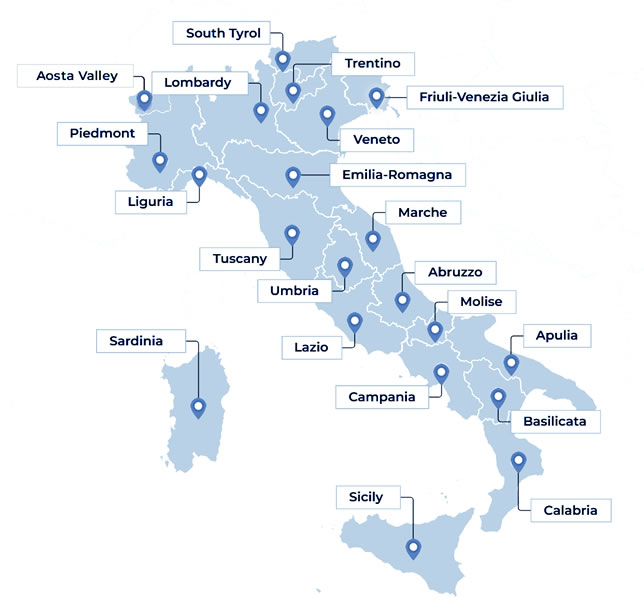

Explore Italy by place | region | time period
Republican Rome » Gatteo (Forlì-Cesena, Emilia-Romagna)
Today, the phrase "crossing the Rubicon" is an idiom that means "passing a point of no return". Its meaning comes from allusion to the crossing of the river Rubicon in northern Italy by Julius Caesar on the night of 10 and 11 January 49 BCE. It caused the Second Civil War and Caesar became dictator for life (dictator perpetuo).
The Rubicon is a small 35 km long watercourse to torrential regime in northern Italy (Forlì-Cesena), which flows into the Adriatic Sea south of Cesenatico.
At that time, it marked the border of the territory of Rome and Cisalpine Gaul.
Until a few years ago, we were not sure which river was the ancient Rubicon. The sources say that it flowed between Rimini and Cesena, where there are three rivers today: Uso, Fiumicino and Pisciatello (Urgòn).
In 1932, Mussolini randomly determined that the Rubicon was the Fiumicino and officially changed its name.
The doubt remained until 2018, when archaeologists discovered the remains of a Roman military settlement with features of frontier garrison at Gatteo, on the limes of the Fiumicino, thus confirming that it was the ancient Rubicon.
The Roman camp extended over an area of more than 30 hectares, and was frequented from the Republican era until the late Antiquity period (III BCE - VI CE).
It developed at the intersection of two important roads: Emilia (consular road that connected Rimini to Piacenza) and another road that descended from the Apennines to the sea.
Today, the idea of turning it into an Archaeological Park is under consideration.
According to legend, Gaius Julius Caesar was a descendant of Aeneas (the Trojan prince who founded Rome, himself the son of the Greek goddess Aphrodite or Venus for the Roman), he was a victorious general for people, but the Roman Senate viewed his military power with suspicion and threatened his authority.
Caesar had been appointed to a governorship over a region that ranged from southern Gaul to Illyricum. After the end of the Gallic wars, the Roman Senate refused Caesar his second consulship. In the late autumn of 50 BCE, when his term of governorship ended, Senate ordered him to give up his commands, to hand over his ten well-trained legions to a new governor, and demanded his return to Rome to face prosecution.
Caesar heard the news in Ravenna, and knew that he had to make a choice between prosecution and rebellion; he preferred the dignity of war over the humiliation of a process. He, sensing the Senate's plot against him and concerned about his own life, refused and stayed encamped in the province assigned to him, near present-day Cervia.
It was against Roman law for any army from a province to cross the border of the river Rubicon into Italy. By law the act was a declaration of war against a state that was rebelling against Rome. However, the previous day, Caesar's forces had already crossed into Italy and occupied Ariminum.
Forced to choose either the end of his political career or civil war. Caesar's perspectives did not look great: nine of his legions were still on duty in Gaul. Caesar chose to rebel.
In the night of 10/11 January, the Legio XIII Gemina (or the 13th Twin Legion, because it was doubled in size by the incorporation of veterans from another legions after the Battle of Actium in 31 BCE) advanced to Rimini, where he could control the passes across the Apennines.
The legion remained faithful to Caesar during the resulting civil war. But it's true that, for Caesar's soldiers everything depended on this one campaign. If they failed, they would never receive their pension. Remaining doubts must have disappeared when Caesar doubled the wages of the legionaries.
The historian Livy said Caesar assailed the world with Legio XIII Gemina. It was recruited by the Roman general in 57 BCE, during the war in Gaul, before he attacked the Belgians. When Caesar's sole rule was safely established, the legion was disbanded and its veterans were given land at Spello in Italy. But, a new Thirteenth Legion is mentioned after 41. This was probably not a new creation but a reconstitution of the old unit.
According to Suetonius, it looks like Caesar hesitated, and finally he is made his decision exclaiming the famous Greek phrase anerrìphtho kybos (alea iacta est in Latin), the die is cast before crossing, and led his army across the river toward Rome.
He crossed the Rubicon at the head of his army, about 5,000 men and 300 horsemen [Caesar, Civil War 1.7-8.] causing the clash with Rome.
In order to know more, you can visit:
- Wikipedia: [1]
This page was last edited on 15 June 2024

Open in Google Maps and find out what to visit in a place.
Go to: Abruzzo | Aosta Valley | Apulia | Basilicata | Calabria | Campania | Emilia Romagna | Friuli Venezia Giulia | Lazio | Liguria | Lombardy | Marche | Molise | Piedmont | Sardinia | Sicily | South Tyrol | Trentino | Tuscany | Umbria | Veneto

Text and images are available under the Creative Commons Attribution-ShareAlike License 4.0; - italystudynotes.eu - Privacy